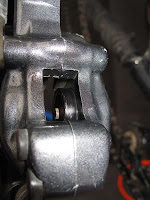Hydraulic brakes on todays bikes are as common as bad stock options and housing forclosures. (note: it's 2010) Fortunatley for you, brakes are a fairly easy fix when something goes wrong.
The majority of brakes use glycol-ether based D.O.T fluid with a rating of at least 4. Avid will start using 5.1 (higher boiling point) in their Elixer models this year. Shimano and Magura have been using Mineral Oil in their systems since the start. Shimano seems to have this sorted out a bit better than Magura when it comes to how the systems hold up under normal operating conditions.
Brake bleeds work by pushing fluid FROM the caliper up TO the lever simultaneously removing air or debris (usually both) that may be caught in the lines. In the pic below, you can see some small black pieces of stuff floating in the fluid. This is what came out of the brake system while bleeding this brake and is typical of what I see when bleeding brakes.
The majority of brakes use glycol-ether based D.O.T fluid with a rating of at least 4. Avid will start using 5.1 (higher boiling point) in their Elixer models this year. Shimano and Magura have been using Mineral Oil in their systems since the start. Shimano seems to have this sorted out a bit better than Magura when it comes to how the systems hold up under normal operating conditions.
Brake bleeds work by pushing fluid FROM the caliper up TO the lever simultaneously removing air or debris (usually both) that may be caught in the lines. In the pic below, you can see some small black pieces of stuff floating in the fluid. This is what came out of the brake system while bleeding this brake and is typical of what I see when bleeding brakes.
 After the system is properly bled, it's a good idea to clean up the pistons to keep them moving freely. In the photo below, I've pushed one of the pistons out of the caliper slightly. Notice the definitive line of dirt on the piston.
After the system is properly bled, it's a good idea to clean up the pistons to keep them moving freely. In the photo below, I've pushed one of the pistons out of the caliper slightly. Notice the definitive line of dirt on the piston. 
A trick I've learned is to use cotton swabs to clean things up. One end of the swab gets soaked in brake fluid (or mineral oil if that's what the brake system uses) and makes it relatively easy to clean all the way around the piston. Once it's clean, use the other end of the swab to "mop up" the excess brake fluid that's accumulated around the piston.
 Once the piston is clean it gets pushed back into the caliper body and the process gets repeated to the other piston on the opposite side of the caliper.
Once the piston is clean it gets pushed back into the caliper body and the process gets repeated to the other piston on the opposite side of the caliper. 
After the pistons are both clean and pushed back into the caliper body, a little isopropyl alcohol is used to remove any remaining brake fluid from the exterior of the caliper.
Every Brake Bleed finishes with a check of the pads to makes sure they have adequate service life and a wipe down of the brake rotor to make sure there's no oil or other foreign substance that would cause underpowered braking.
